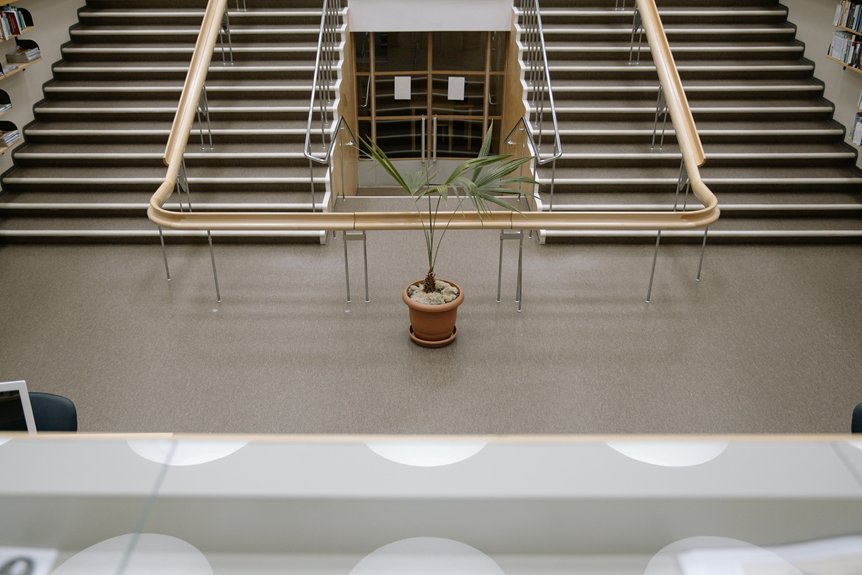When it comes to exterior waterproofing your basement, understanding the necessary steps is vital for long-term effectiveness. You’ll need to assess your home’s drainage systems and prepare the exterior properly before excavation. This process includes installing a reliable waterproof membrane and a drainage system to manage groundwater effectively. Each step requires precision and attention to detail to prevent future moisture issues. So, what are the essential techniques to guarantee your efforts aren’t in vain?
Key Takeaways
- Clear debris and vegetation within three feet of the foundation to ensure proper drainage and access for waterproofing work.
- Adjust the grading around the foundation to create a slope that directs water away from the home.
- Excavate around the foundation to a depth of 8-12 inches for the installation of drainage systems and waterproof barriers.
- Install a perforated drainage pipe at the base of the foundation to collect and redirect water effectively.
- Apply high-quality waterproofing membranes and sealants to foundation walls to prevent water intrusion.
Assessing Your Basement’s Waterproofing Needs
How can you determine if your basement requires waterproofing? Start by identifying leaks, which can manifest as water stains, mold, or peeling paint.
Inspect walls and floors for damp spots, particularly after heavy rains. Next, analyze potential moisture sources, like plumbing leaks or poor drainage outside.
Pay close attention to window wells and cracks in the foundation, as these can allow water intrusion. If you notice persistent humidity or musty odors, it’s essential to act.
Understanding Water Drainage Systems
While understanding water drainage systems may seem complex, grasping their fundamentals is essential for effective basement waterproofing. You need to recognize the different drainage system types and how they interact with water flow patterns around your home.
Grasping the fundamentals of water drainage systems is crucial for effective basement waterproofing and safeguarding your home.
Here are three key components to take into account:
- Surface Drains: These collect and redirect rainwater away from your foundation.
- French Drains: These systems channel groundwater into a perforated pipe, preventing flooding.
- Sump Pumps: These actively remove water that accumulates in your basement, ensuring it stays dry.
Understanding these elements will help you design a robust waterproofing strategy.
Preparing the Exterior of Your Home
Before you begin the waterproofing process, you must prepare the exterior of your home to create an effective barrier against moisture.
Start with landscape preparation; clear any debris, vegetation, or obstructive features within a three-foot radius of your foundation.
Next, conduct a soil analysis to determine drainage patterns and soil composition. This helps identify areas prone to water retention or erosion.
Adjust the grade around your foundation to guarantee water flows away from your home.
Proper grading and landscape management are essential in minimizing moisture infiltration, setting the stage for successful waterproofing and protecting your basement from potential water damage.
Excavating Around the Foundation
Excavating around your foundation is a significant step in the waterproofing process, as it allows for the installation of effective drainage systems and waterproof barriers.
To guarantee foundation stability and prevent soil erosion, follow these key steps:
- Dig to the appropriate depth: Aim for at least 8-12 inches below the footing to facilitate proper drainage.
- Create a slope for water diversion: Make sure the soil slopes away from your foundation to direct water away.
- Identify utilities and potential obstructions: Locate any buried lines or structures to avoid damage during excavation.
These actions are essential for maintaining a dry basement and long-lasting structural integrity.
Installing a Waterproof Membrane
One essential component of effective exterior waterproofing is installing a waterproof membrane around your foundation.
Start by selecting high-quality waterproof membranes, like polyethylene or rubberized asphalt. Verify the surface is clean and dry before application.
Choose durable waterproof membranes, such as polyethylene or rubberized asphalt, and ensure the surface is clean and dry before applying.
Use the correct installation techniques, such as overlapping seams and sealing edges to create a continuous barrier. Apply adhesive uniformly for proper attachment, and consider using a trowel for added pressure.
Pay attention to any penetrations, sealing them thoroughly to prevent moisture ingress.
Finally, inspect the membrane for any defects before backfilling to guarantee maximum protection against water infiltration.
Applying a Drainage System
To effectively manage water around your basement, applying a drainage system is crucial for preventing moisture buildup. A well-designed drainage system directs water flow away from your foundation, minimizing the risk of leaks and damage.
Here’s how to implement it:
- Install a Perimeter Drain: Position it around the foundation’s base to capture groundwater before it can penetrate.
- Use Drainage Pipes: Confirm they’re sloped for effective water flow, directing excess water to a designated outlet.
- Incorporate a Sump Pump: This helps remove water that accumulates in the drainage system, further protecting your basement from flooding.
Backfilling and Compacting Soil
Backfilling and compacting soil around your basement is vital for maintaining structural integrity and preventing water infiltration.
You’ll need to follow specific techniques for compacting the soil to guarantee stability and proper drainage.
Consideration of drainage during the backfilling process is essential to avoid future moisture issues.
Importance of Proper Backfilling
Proper backfilling is essential for guaranteeing the stability and longevity of your basement’s waterproofing system.
Using suitable backfill materials and effective backfill techniques minimizes water infiltration and soil settlement. Here are three key considerations:
- Material Selection: Use clean, granular materials like crushed stone or gravel, which promote drainage and reduce pressure on the waterproofing membrane.
- Layering: Backfill in layers, compacting each layer thoroughly to prevent voids that can lead to settling.
- Moisture Control: Keep the backfill slightly damp during compaction to achieve ideal density and prevent erosion.
Implementing these steps guarantees a robust foundation for your waterproofing efforts.
Techniques for Soil Compaction
When you’re preparing to compact soil during backfilling, understanding the right techniques is crucial for achieving ideal results.
Start by evaluating the soil density; it should be at suitable moisture content to guarantee effective compaction. Use a mechanical compactor or vibratory plate for uniform compaction.
Apply compaction techniques in layers, ideally 6 to 8 inches at a time, to avoid overloading the soil. After each layer, check for uniform density with a density gauge.
Properly compacted soil prevents settlement and enhances the stability of your foundation, reducing the risk of water intrusion and providing long-lasting results.
Drainage Considerations During Backfilling
Effective drainage is essential during the backfilling process to prevent water accumulation around your foundation.
Consider the following drainage patterns and soil types as you backfill:
- Sloped Backfill: Make sure the soil slopes away from your foundation, promoting proper drainage.
- Granular Soil: Use granular soil types for backfill, as they encourage drainage and reduce water retention.
- Drainage Pipes: Install perforated drainage pipes at the base of your foundation to collect and redirect water effectively.
Ensuring Proper Grading and Landscaping
To protect your basement from water intrusion, guarantee the ground slopes away from your foundation.
This grading directs rainwater away, preventing pooling around the base of your home.
Additionally, maintain clear drainage paths to facilitate proper runoff and avoid potential water damage.
Slope Away Foundations
While proper grading and landscaping may seem like minor details, they play an essential role in guaranteeing that water drains away from your foundation effectively.
A well-designed slope away from your foundation minimizes water accumulation, especially in areas with high water tables.
Consider these key aspects:
- Grade the soil: Guarantee a slope of at least 6 inches over the first 10 feet away from your foundation.
- Use landscaping features: Incorporate swales or berms to redirect water flow.
- Select appropriate plants: Choose drought-resistant plants that won’t disrupt your foundation design while controlling erosion.
These strategies help maintain your basement’s integrity.
Maintain Drainage Paths
Confirming that drainage paths remain unobstructed is essential for preventing water from pooling around your foundation.
To achieve effective water diversion, regularly inspect and maintain your landscaping. Verify that soil slopes away from the foundation, promoting the natural flow of water.
Utilize appropriate drainage solutions, such as French drains or swales, to guide water away from your home. Keep gutters and downspouts clear, directing runoff well away from your property.
Regular Maintenance and Monitoring
Regular maintenance and monitoring of your basement’s exterior waterproofing system are essential to preventing water intrusion and structural damage.
Implementing routine inspections and moisture monitoring guarantees the integrity of your waterproofing efforts.
- Conduct routine inspections every six months to identify any cracks or damage in the waterproofing membrane.
- Monitor moisture levels using hygrometers, especially during heavy rainfall or snowmelt.
- Clear drainage paths of debris regularly to maintain proper water flow away from your foundation.
Conclusion
Successfully waterproofing your basement requires careful attention to detail at each step. By evaluating your needs, preparing the exterior, and ensuring proper installation of drainage systems and waterproof membranes, you can effectively protect your home from moisture intrusion. Don’t overlook the significance of backfilling and grading, as they play an essential role in directing water away from your foundation. Finally, regular maintenance and monitoring will help you catch potential issues early, ensuring long-lasting protection for your basement.

